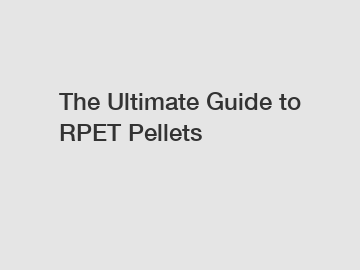The Ultimate Guide to RPET Pellets
The Ultimate Guide to RPET Pellets: What Makes Them the Perfect Solution for Sustainable Packaging?
With the increasing focus on sustainability and the urgent need to reduce our environmental footprint, industries around the world are seeking innovative solutions to tackle the problems caused by plastic waste. One such solution gaining prominence is the use of RPET pellets, which stand for Recycled Polyethylene Terephthalate. These pellets, produced from recycled materials, offer a promising alternative to traditional plastic, making them an ideal choice for sustainable packaging. In this ultimate guide, we will discuss the key features, benefits, applications, and the future outlook of RPET pellets to understand why they have quickly become the go-to solution for environmentally conscious businesses.
1. What are RPET pellets?

RPET pellets are made from post-consumer recycled plastic bottles, primarily comprised of polyethylene terephthalate (PET). After collection, the bottles go through an extensive recycling process that involves cleaning, shredding, melting, and extrusion, resulting in small pellet-like forms. These pellets have similar properties to virgin PET and can be used as a valuable raw material in the production of new products.
2. The benefits of RPET pellets:
a. Environmental impact: By utilizing RPET pellets, businesses can significantly reduce their reliance on virgin plastics, therefore decreasing the demand for crude oil and energy consumption. In turn, this reduces greenhouse gas emissions and helps combat climate change.
b. Waste reduction: The recycling process of plastic bottles to RPET pellets diverts tons of plastic waste from landfills, enabling effective waste management and reducing pollution of natural habitats.
c. Energy savings: Manufacturing products using RPET pellets requires less energy compared to the production of virgin plastics. This energy efficiency helps conserve valuable resources and reduces the carbon footprint associated with creating new plastic items.
d. Versatility: RPET pellets can be used in a wide range of applications. From food and beverage packaging to textiles and industrial materials, the versatility of RPET pellets makes them an ideal choice for businesses across various sectors.
e. Cost-effectiveness: While initially, the cost of RPET pellets may be slightly higher than traditional plastic, their durability, reusability, and recyclability offer long-term cost savings, making them a smart and economically viable choice for businesses aiming for sustainable packaging solutions.
3. Applications of RPET pellets:
a. Packaging industry: RPET pellets are commonly used to create sustainable packaging for food and beverages, personal care products, pharmaceuticals, and more. The ability to produce clear, lightweight, yet strong packaging enables businesses to meet consumer demands while reducing their environmental impact.
b. Textile industry: RPET pellets can be transformed into polyester fibers, which are further processed to create sustainable textiles. These textiles find applications in clothing, home furnishings, and a myriad of other products, providing eco-conscious consumers with an eco-friendly alternative that doesn't compromise on quality or style.
c. Industrial materials: The strength and durability of RPET pellets make them suitable for various industrial applications. From construction materials to automotive components, RPET pellets can be used to replace traditional plastics, minimizing waste and maximizing resource efficiency.
4. The future of RPET pellets:
As environmental concerns continue to grow, the demand for sustainable alternatives such as RPET pellets will undoubtedly increase. With advancements in recycling technologies, manufacturing processes are becoming more efficient, resulting in improved quality and performance of RPET pellets. Investments in research and development are driving innovation in areas like bioplastics, which utilize renewable resources rather than petroleum. This, coupled with increased consumer awareness and regulations promoting sustainable practices, will likely accelerate the adoption of RPET pellets and other eco-friendly materials in the coming years.
In conclusion, RPET pellets offer a sustainable solution for the packaging industry and beyond. With their positive environmental impact, waste reduction capabilities, versatility, and potential cost savings, RPET pellets have quickly gained recognition as a key component in the transition towards a more sustainable future. By embracing and investing in the use of RPET pellets, businesses can contribute significantly to the reduction of plastic waste, conserve valuable resources, and play their part in creating a more environmentally conscious society. So, why wait? Join the movement towards a greener future with RPET pellets today!
Want more information on rPET pellets, rPET pellets, rPET pellets? Feel free to contact us.
301
0
0

Comments
All Comments (0)